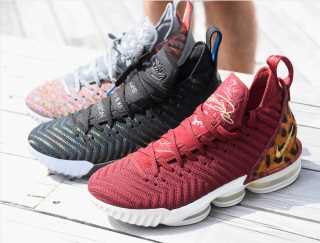Partnerships are paramount in the success of Black designers and creatives in the fashion industry.
And if you ask leaders at Nike Inc., the path to success and a viable business is supporting others and support from others.
Melanie Auguste, who serves as vice president of global brand defining, purpose and athlete brand marketing, and Josh Wachtel, general manager, LeBron James and athlete business development, discussed their approaches to collaborations and what makes a partnership effective at the recent Harlem’s Fashion Row summit.
“It always starts with an insight or consumer problem, and we work with a collaborator to help us with that,” said Wachtel. “We’re figuring out why we’re doing [the collaboration] and what problem we’re solving…in addition, especially where we are today, adding on what we can learn today as an organization. [We could] go find someone who can help us do this, but we also ask who’s already doing this and put shine on them.”
Nike collaborated with Harlem’s Fashion Row on the LeBron 16 sneaker to commemorate the HFR Style Awards and Fashion Show. Brandice Daniel, founder and chief executive officer of HFR, tapped designers Fe Noel, Undra Celeste and Kimberly Goldson to partner on the sneaker, marking the first time a LeBron James sneaker had been designed by all women designers. Nike and James sponsored the event, another first for HFR at the time.

Related Gallery
Hubert de Givenchy’s 1970s Black Cabine Models Made a Statement About Diversity
“I had reached my lowest before that moment,” Daniel said candidly about the partnership. She spoke of looking for a partnership prior to Nike’s call, and lo and behold, the sportswear giant was right on time to bring Daniel’s wish to life.
Though Auguste wasn’t sure initially how well the idea for the project would be received, it turned out to be a successful collaboration. “After that first meeting, it really was just about doing it right and every meeting we had even more confidence,” she said.
Beyond collaborations, sometimes it’s just about opportunities — like those afforded to Sergio Hudson when Michelle Obama chose a look from the designer for Inauguration Day and Vice President Kamala Harris emerged in an eveningwear look from Hudson for the inaugural concert.
The Columbia, South Carolina native had previously dressed Kendall Jenner for her 20th birthday, Jennifer Lopez in a leopard print dress for NBC’s World of Dress, and Michelle Obama twice in 2019 in Atlanta and at Essence Fest for her tour supporting her memoir, “Becoming.” Harlem’s Fashion Row had even named Hudson among the recipients of its Icon 360 fund in 2020, which doled out grants totaling $1 million. But dressing the former first lady in a fan-favorite look seen around the world is a different affair altogether.
Hudson watched the inauguration at an airport lounge and said he heard audible gasps when Obama appeared on screen. “I felt it in the atmosphere, it was immediate,” he said speaking at the Harlem’s Fashion Row summit. His brand website crashed shortly after, and he removed his website email account from his phone, because of the influx of notifications.
“For a split second, I forgot I made the outfit,” he joked. “The girl next to me was like, ‘I have to see who made it’ and she looked it up not knowing I was right there next to her. I will never forget the moment. It signaled a change in my career.”
And when you dress the first female, first Black, first Asian American vice president of the United States, the momentum just keeps going. “Being a father of Black girls, it was a privilege and an honor,” he said. “I want to be a part of history.”
Hudson, however, didn’t always have the support he’s seeing now. Once, during a meeting with a buyer of a Los Angeles boutique, the buyer said his clothes “should be more urban.”
“They expect me to design urban clothes, because I’m Black,” he said. “Growing up loving fashion, I didn’t realize there were blockades in the industry. You grow up loving fashion, and they love everyone but they ignore the color issue.”
There is a disconnect of being a “big, Black man from the South” and the clothing that he produces, he said. Buyers don’t expect him to be the designer, despite his ability to sketch, drape, make patterns and sew.
“We are Black designers, but we want to be designers,” he said. “We have to say that now, but the end goal should be it’s just normal for a Black designer to just be a designer. The top American designers in New York right now are Asian men: Alexander Wang, Prabal Gurung, Joseph Altuzzara. People don’t even think about it.”
Source: Read Full Article
